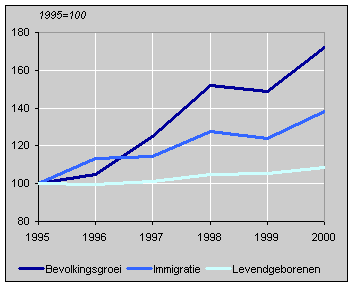Dutch population growing faster

The Dutch population grew by 120,000 people last year. In 1995 the increase was still only 70,000 people. The acceleration of this growth rate was mainly caused by the strong rise in immigration: from 96,000 in 1995 to 133,000 in 2000. The number of births also rose substantially, from 191,000 in 1995 to 207,000 in 2000. Opposite the strong rise in immigration and births was a smaller increase in mortality, and a decrease in emigration last year.
Population growth

Immigration was relatively low in the mid-nineties, partly because of the restrictive policy measures introduced in 1993 and 1994. Although the drop in immigration was intensified by the economic decline at the time, the decrease turned out to be only temporary. In 1998 immigration rose strongly again, and in 2000 it increased further.
An important part of the increase is caused by the growing number of asylum-seekers. The shortening of the registration procedure for asylum-seekers has also had an effect in this respect. Until recently asylum-seekers were recorded in the population registration one year after submitting a request for asylum. In 2000 this period was reduced to six months.
The labour shortage in the Netherlands is also attracting of a growing number of labour migrants, pushing up immigration further.
The increase in the number of births is partly connected with the economic growth. As confidence in the economy increases, one and a half years later the birth rate also increases.
As the economic climate affects both the number of births and the number of immigrants, the two often rise and fall simultaneously. This is an important reason for the strong fluctuations in population growth.
Joop de Beer